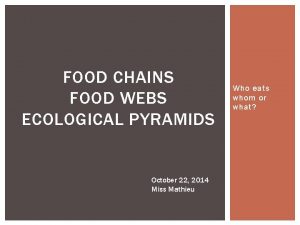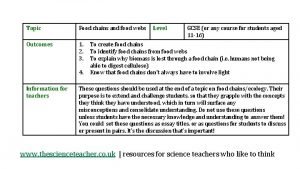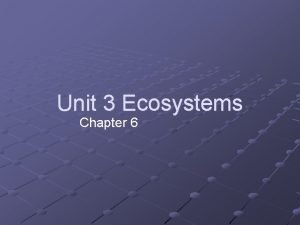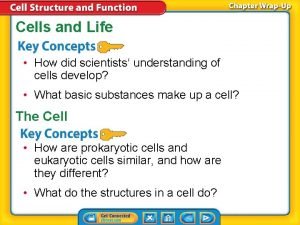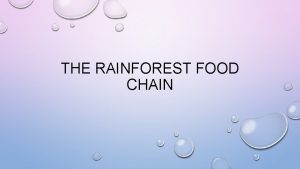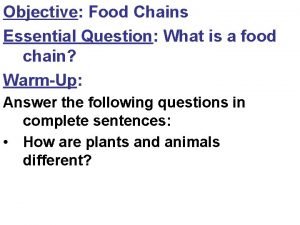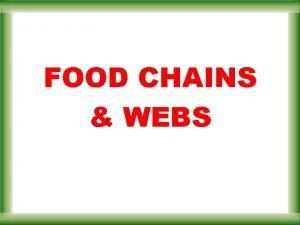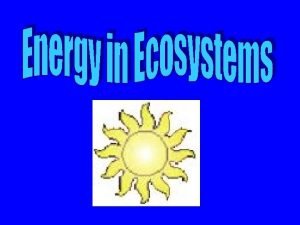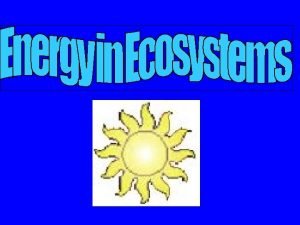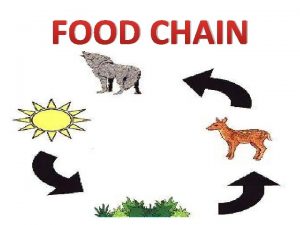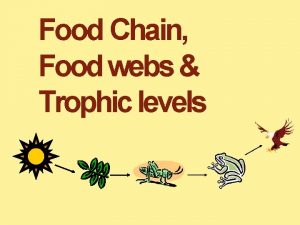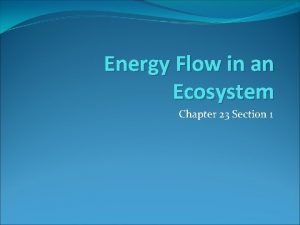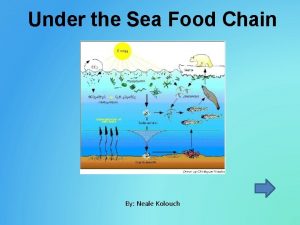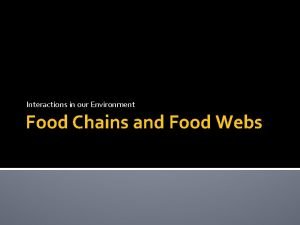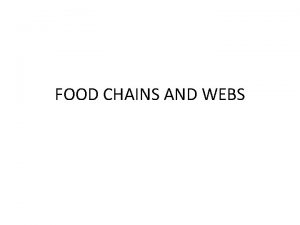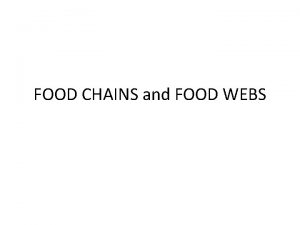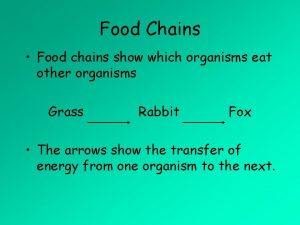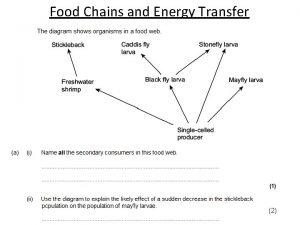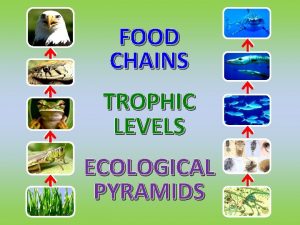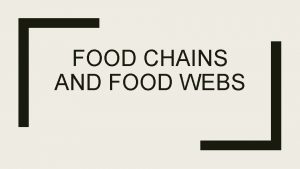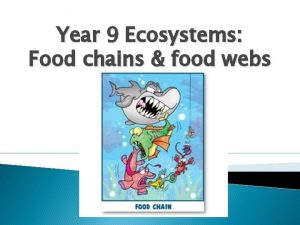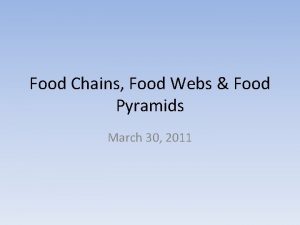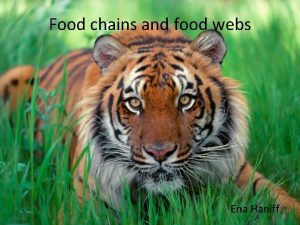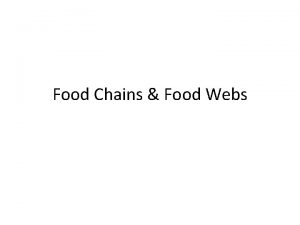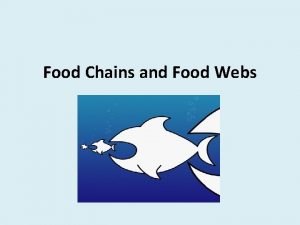Food Chains Thermodynamics Goal To develop an understanding
























- Slides: 24

Food Chains & Thermodynamics

Goal • To develop an understanding of the interdependence of all organisms and the need for conserving natural resources

Concept • Concept: Living organisms share in a variety of complex interrelationships which are based on interdependence. • Concept Objective: To understand that energy does not cycle within an ecosystem

Energy changes in the ecosystem A. First law of thermodynamics B. Second law of thermodynamics

1 st Law of Thermodynamics • Rub hands together • Place on face • What happened?

1 st Law of Thermodynamics • The First Law of Thermodynamics states that energy cannot be created or destroyed but only changes forms. • In the introductory activity chemical energy in our bodies was changed to mechanical energy in our arms. – Friction caused some of this mechanical energy to be changed to noticeable heat energy in our hands. – We also felt some of the heat move to our cooler faces.

1 st Law of Thermodynamics • The First Law of Thermodynamics states that energy cannot be created or destroyed but only changes forms. • A practical ecological consequence of this law is that all living things must have a source of energy. • The ultimate source of energy for most living things is the sun.

2 nd Law of Thermodynamics • The Second Law of Thermodynamics states that at every energy transfer some portion of the available energy is degraded to heat which moves to cooler objects. • We felt the heat in our hands move to our cooler face.

2 nd Law of Thermodynamics http: //www. epa. gov/mercury/exposure. htm • • Producers are the only organisms that are able to take the radiant energy from the sun and change it to chemical energy in food, glucose sugar. In the process of photosynthesis producers use carbon dioxide and water, in the presence of chlorophyll and light, to make sugar and oxygen. – In the "light" phase of photosynthesis energy-rich adenosine triphosphate (ATP) molecules are formed. – In "dark" phase a variety of substances required to build and maintain tissues are produced. – Plants may convert as much as 75 percent of the light received into chemical energy in glucose sugar. • • Organisms in the environment have very poor efficiency in converting the energy they receive into usable energy or into energy which is stored and eaten by the next link on a food chain.

• On average vertebrates use about 98% of assimilated energy for metabolism, leaving only 2% for growth and reproduction. This is largely because they are regulating their temperature • On average, invertebrates use only ~80% of assimilated energy for metabolism, and thus exhibit greater net production efficiency (~20%) than do vertebrates. • Plants have the greatest net production efficiencies, which range from 30 -85%. http: //www. globalchange. umich. edu/globalchange 1/current/lectures/kling/highertrophic/trophic 2. html#transfer

• • 300 trout are needed to support one man for a year. The trout, in turn, must consume 90, 000 frogs, that must consume 27 million grasshoppers that live off of 1, 000 tons of grass. -- G. Tyler Miller, Jr. , American Chemist (1971) • Only a fraction of the energy available at one trophic level is transferred to the next trophic level. (which law of thermodynamics is this? ) The rule of thumb is 10%, but this is very approximate. • Typically the numbers and biomass of organisms decrease as one ascends the food chain.

REVIEW 1. Can energy be created or destroyed? 2. This is a statement of what law? 3. Which living things are able to convert radiant or solar energy into usable chemical energy? 4. As food moves through an ecosystem is all the energy converted into usable energy? 5. This is a statement of what law?

REVIEW • 1. Can energy be created or destroyed? (No) • 2. This is a statement of what law? (First Law of Thermodynamics) • 3. Which living things are able to convert radiant or solar energy into usable chemical energy? (Producers or plants) • 4. As food moves through an ecosystem is all the energy converted into usable energy? (No) • 5. This is a statement of what law? (Second Law of Thermodynamics)

Radiant energy to chemical energy A. Photosynthesis 6 H 2 O + 6 CO 2 -----> C 6 H 12 O 6+ 6 O 2 • • Light phase: solar energy is harvested and transferred into the chemical bonds of ATP; can occur only in light. In a series of reactions the energy is converted (along an electron transport process) into ATP and NADPH. Water is split in the process, releasing oxygen as a by-product of the reaction. http: //www. emc. maricopa. edu/faculty/farabee/BIOBK/Bio. Book. PS. html

Radiant energy to chemical energy Dark phase: carbon dioxide from the atmosphere (or water for aquatic/marine organisms) is captured and modified by the addition of Hydrogen to form carbohydrates http: //web. mit. edu/esgbio/www/ps/dark. html

Radiant energy to chemical energy B. Energy conversions happened with: • Phosphorylation • Oxidation-reduction reactions http: //www. emc. maricopa. edu/faculty/farabee/BIOBK/Bio. Book. PS. html

Release of energy A. • • • Movement of energy to other organisms Energy moves through the ecosystem as consumers eat and as decomposers decay other organisms. The energy stored in glucose may be released when organisms burn food in their cells during respiration. (Note: respiration occurs in the cells of producers, consumers, and decomposers. ) These energy releasing reactions usually occur in the cell mitochondria. Oxygen is combined with glucose forming water and carbon dioxide with the release of energy. This is just opposite of the photosynthesis reaction. For example: exercise vigorously for a few minutes. Observe the rapid breathing, increased heart rate, skin changes, and other evidence of increased respiration

Release of energy 1. 2. In the cytoplasm is glycolysis In the mitochondria is cellular respiration Under aerobic conditions there are 2 reactions the Kreb’s cycle and electron transport • – – – In the Kreb’s cycle the small chain carbons are completely oxidized and a small amount of energy is the result (ATP, NADH) Electron transport is where more energy in the form of ATP is produced through oxidative phosphorylation Note: oxidation-reduction reactions are a reaction in which electrons are transferred from a donor (the reducing agent) to an acceptor molecule (the oxidizing agent). image is from http: //www. biosci. uga. edu/almanac/bio_104/notes/jun_4. html.

Release of energy B. Power for life processes • The energy released by respiration is used to power the life processes of organisms including: – movement, growth, chemical synthesis, movement of materials in the organism, reproduction, and others. • Much of the energy released in respiration is lost to the environment as heat.

Loss of chemical energy A. Use of energy by organisms: Energy moves through the ecosystem as consumers eat and as decomposers decay other organisms. B. Loss of heat energy: Much of the energy released in respiration is lost to the environment as heat. The energy stored in glucose may be released when organisms burn food in their cells during respiration. • – • (Note: Respiration occurs in the cells of producers, consumers, and decomposers. ) These energy releasing reactions usually occur in the cell mitochondria. C. Stored Energy – next slide

Loss of chemical energy C. Stored energy (glucose) 1. There are in general many more producers 2. Limiting numbers on a pyramid because of the loss of stored energy as you move up the food chain.

In Summary • The energy released by respiration is used to power the life processes of organisms including movement, growth, chemical synthesis, movement of materials in the organism, reproduction, and others.

Review 1. What happens to the amount of energy available as you move to higher levels on a food pyramid? 2. On the average, it decreases how many times as you move up one level? 3. How many times would the energy decrease if you moved up two levels? , three levels? , four levels?

Review 1. What happens to the amount of energy available as you move to higher levels on a food pyramid? (It decreases) 2. On the average, it decreases how many times as you move up one level? (10) 3. How many times would the energy decrease if you moved up two levels? (100), three levels? (1000), four levels? (10, 000)
 Third level consumer
Third level consumer Section 4: food chains and food webs
Section 4: food chains and food webs Food chains, food webs and ecological pyramids
Food chains, food webs and ecological pyramids Food chains food webs and energy pyramid worksheet
Food chains food webs and energy pyramid worksheet Chaparral food chains
Chaparral food chains How many food chains are there in the food web
How many food chains are there in the food web Difference between food webs and food chains
Difference between food webs and food chains How did scientists understanding of cells develop
How did scientists understanding of cells develop Rainforest animals food chain
Rainforest animals food chain Objective of food chain
Objective of food chain Food chain
Food chain Food web clip art
Food web clip art Where are decomposers in a food web
Where are decomposers in a food web A model that shows how food chains overlap
A model that shows how food chains overlap A series of events in which one organism eats another
A series of events in which one organism eats another Swamp food chains
Swamp food chains Food chains start with what
Food chains start with what Food chain for a lion
Food chain for a lion Importance of food chains
Importance of food chains Importance of food chains
Importance of food chains Desert food chain example
Desert food chain example Nutrient chain foldable
Nutrient chain foldable Sea food chain
Sea food chain Mountain lion food chain
Mountain lion food chain Food web def
Food web def


